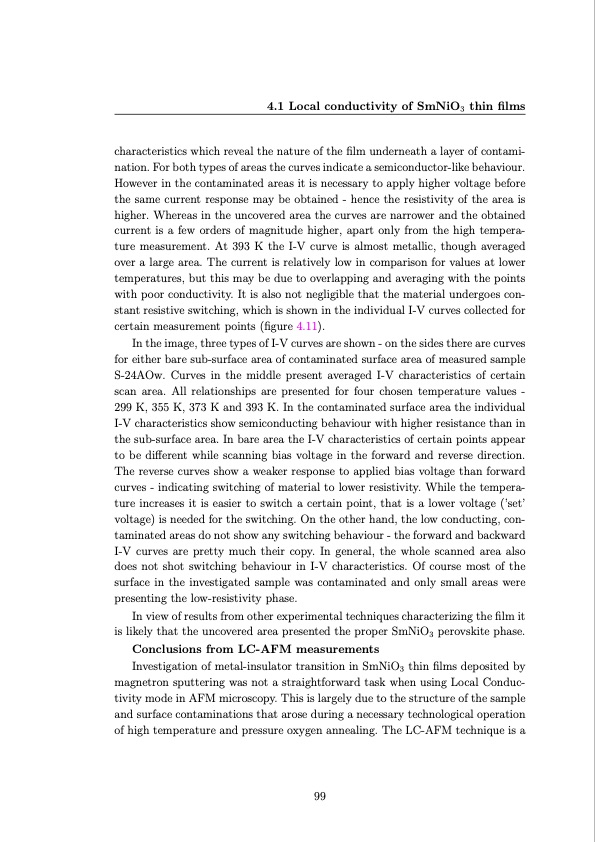
PDF Publication Title:
Text from PDF Page: 120
4.1 Local conductivity of SmNiO3 thin films characteristics which reveal the nature of the film underneath a layer of contami- nation. For both types of areas the curves indicate a semiconductor-like behaviour. However in the contaminated areas it is necessary to apply higher voltage before the same current response may be obtained - hence the resistivity of the area is higher. Whereas in the uncovered area the curves are narrower and the obtained current is a few orders of magnitude higher, apart only from the high tempera- ture measurement. At 393 K the I-V curve is almost metallic, though averaged over a large area. The current is relatively low in comparison for values at lower temperatures, but this may be due to overlapping and averaging with the points with poor conductivity. It is also not negligible that the material undergoes con- stant resistive switching, which is shown in the individual I-V curves collected for certain measurement points (figure 4.11). In the image, three types of I-V curves are shown - on the sides there are curves for either bare sub-surface area of contaminated surface area of measured sample S-24AOw. Curves in the middle present averaged I-V characteristics of certain scan area. All relationships are presented for four chosen temperature values - 299 K, 355 K, 373 K and 393 K. In the contaminated surface area the individual I-V characteristics show semiconducting behaviour with higher resistance than in the sub-surface area. In bare area the I-V characteristics of certain points appear to be different while scanning bias voltage in the forward and reverse direction. The reverse curves show a weaker response to applied bias voltage than forward curves - indicating switching of material to lower resistivity. While the tempera- ture increases it is easier to switch a certain point, that is a lower voltage (’set’ voltage) is needed for the switching. On the other hand, the low conducting, con- taminated areas do not show any switching behaviour - the forward and backward I-V curves are pretty much their copy. In general, the whole scanned area also does not shot switching behaviour in I-V characteristics. Of course most of the surface in the investigated sample was contaminated and only small areas were presenting the low-resistivity phase. In view of results from other experimental techniques characterizing the film it is likely that the uncovered area presented the proper SmNiO3 perovskite phase. Conclusions from LC-AFM measurements Investigation of metal-insulator transition in SmNiO3 thin films deposited by magnetron sputtering was not a straightforward task when using Local Conduc- tivity mode in AFM microscopy. This is largely due to the structure of the sample and surface contaminations that arose during a necessary technological operation of high temperature and pressure oxygen annealing. The LC-AFM technique is a 99PDF Image | Investigation of metal-insulator transition in magnetron sputtered samarium nickelate thin films

PDF Search Title:
Investigation of metal-insulator transition in magnetron sputtered samarium nickelate thin filmsOriginal File Name Searched:
Bilewska_Investigation_of_metal_insulator_transition_in_magnetron_sputtered_samarium.pdfDIY PDF Search: Google It | Yahoo | Bing
Sulfur Deposition on Carbon Nanofibers using Supercritical CO2 Sulfur Deposition on Carbon Nanofibers using Supercritical CO2. Gamma sulfur also known as mother of pearl sulfur and nacreous sulfur... More Info
CO2 Organic Rankine Cycle Experimenter Platform The supercritical CO2 phase change system is both a heat pump and organic rankine cycle which can be used for those purposes and as a supercritical extractor for advanced subcritical and supercritical extraction technology. Uses include producing nanoparticles, precious metal CO2 extraction, lithium battery recycling, and other applications... More Info
| CONTACT TEL: 608-238-6001 Email: greg@infinityturbine.com | RSS | AMP |